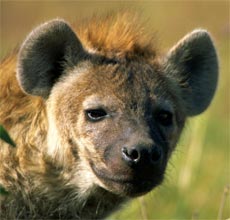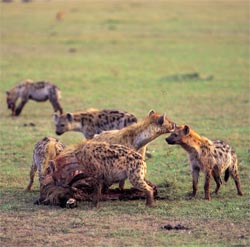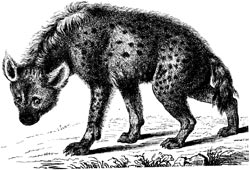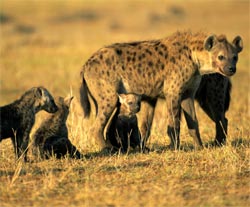|

Not a Dog: Although hyenas look like rather large wild dogs, they make up a separate biological family which is most closely related to Herpestidae (the family of mongooses and meerkats).
 Bone-crushing: The hyena has one of the strongest jaws in the animal kingdom and an adult of the species has only the large cats of the family Felidae (Lions, Tigers, etc.) to fear. An adult hyena's bite pressure can reach 800 lbs. per inch; it can crush bone. Bone-crushing: The hyena has one of the strongest jaws in the animal kingdom and an adult of the species has only the large cats of the family Felidae (Lions, Tigers, etc.) to fear. An adult hyena's bite pressure can reach 800 lbs. per inch; it can crush bone.
Just the Facts: Hyenas range in length from 1.2 - 1.5 meters (3.9 - 4.9 ft) including the tail, which is 30 cm (12 inches) in length. An adult hyena weighs between 25 and 55 kg (55 - 120 lb). The pelt can be light to dark-brown on brown hyenas, while the color can be gray, sometimes nearly white on striped hyenas Aardwolves have a warm, sand-colored coat, while the coats of spotted hyenas can range from dark-brown fur to amber and reddish in color. However, some hyenas such as those in the lion king have spots.
Built for the Chase: Their front legs are actually longer than their back legs, giving them their distinctive gait. This feature, along with the fact that they have a heart twice the size of an adult lion, allows them to stalk their prey for many miles at about 6 mph, waiting for their prey to become exhausted from the chase, and then they can move in very quickly at speeds of up to 30 mph.
Brains and Brawn: Hyenas are also highly intelligent predators, even more intelligent than the lions (some scientists claim they are of equal intelligence to certain apes). One indication of hyena intelligence is that they will move their kills closer to each other to protect them from scavengers; another indication is their strategic hunting methods.

Hunting Strategy: The spotted hyenas are an example of how the cooperative form of hunting can be dictated by the type of prey, as well as the predator’s ability to hunt and kill the different types of prey.
 When the hyenas hunt an animal that is bigger than themselves, they act in a dog or wolf-like behavior; they hunt in packs and together take down the prey by biting into it and dragging it to the ground. If they are after smaller prey, they will hunt alone in a fox-like manner. When the hyenas hunt an animal that is bigger than themselves, they act in a dog or wolf-like behavior; they hunt in packs and together take down the prey by biting into it and dragging it to the ground. If they are after smaller prey, they will hunt alone in a fox-like manner.
Like dogs, but unlike other animals in the same habitat, hyenas do not kill their prey directly. Having chased their prey to exhaustion, their prey is unable to mount any further defense of itself, and is captured and eaten while still alive. Although somewhat distasteful from the human perspective, the speedy disembowelment of the prey means that death often comes sooner than with the methods employed by other predators (for example, suffocation) and is an efficient means of eating which lessens the probability of the kill being lost to another predator.
When in Rome... Hyenas adapt their specific hunting strategy to the environment in which they live. In the Ngorogoro Crater, there is a very rich and concentrated amount of prey, and there are relatively many great beasts such as wildebeest or zebras. These animals are very much bound to one place and don’t migrate. Here, hyenas live in large clans (between 10-100 members per Clan) and have established hunting territory which they often defend against neighboring clans. The amount of large prey animals makes cooperative hunting more necessary than in the Serengeti, for example, where the clans often aren’t that large and must follow the herds when they migrate. Hyenas following migrating prey are less territorial, and will often hunt small animals individually as well as large ones in packs. An adult hyena is capable of taking down a fully grown wildebeest alone, but hunting in packs is proven to be more effective and fast.
 Family Disputes: Hyenas within the same clan rarely fight in a way that can damage them seriously. Most bickering is settled quickly, even by members that have similar ranking in the social hierarchy. Some loud noises and a couple of light bites is usually enough, and if the fight ever gets out of hand, it is quite normal for a hyena of a higher rank to step in and interrupt the fight. Family Disputes: Hyenas within the same clan rarely fight in a way that can damage them seriously. Most bickering is settled quickly, even by members that have similar ranking in the social hierarchy. Some loud noises and a couple of light bites is usually enough, and if the fight ever gets out of hand, it is quite normal for a hyena of a higher rank to step in and interrupt the fight.
Even hyenas that are strange to each other would rather avoid battle than recklessly try to kill each other. Usually, scent marking territories avoids conflicts: if a lone hyena should enter a hostile territory anyway, it keeps a low profile and stays out in the borders. Female hyenas are treated with more hostility than males, since males from different clans are needed for breeding in the clan. Strangers are rarely accepted in a clan, but if so, they are usually placed at the bottom of the ranking system. If a clan member spots an intruder, it will quickly start scent marking, to make the intruder aware that he is not welcome. Furthermore, the clan member will raise its tail and make a whooping noise to warn the rest of the clan. Typically, the intruder will slink away before any physical contact is made.
Clan Warfare: The situation is different, however, when it comes to two clans fighting each other. Hyena clans may try to take over weaker clans' territories, because of lack of prey or peace in their own territory. Human interaction is especially a reason for some clans do this: the more hyena territories shrink in and the wild animals are chased away to protect the livestock of the farmers, the more this tense clan rivalry is sharpened.
Digestive Dynamo: Hyenas have extremely strong jaws and compared to their body size, they are the most powerful of the Animal Kingdom. They also have a very powerful digestive system with highly acidic fluids. This makes them capable of eating and digesting their entire prey - including skin, teeth, horns, hooves and even bones. Since they eat carcasses, their digestion system deals very well with bacteria as well.
The Clan Can: A group of spotted hyenas (called a "clan") can include 5-90 members and is led by a single alpha female called the matriarch. A complicated social hierarchy governs the clan, which cubs often learn before they begin to walk. Females are the dominant members, followed in rank by cubs, while adult males rank lowest. Male hyenas, which are usually smaller and less aggressive than females, often leave the clan when they are about two years old. Females tend to mate with males from other clans, thereby preventing inbreeding.
 Unlike many other animals, female hyenas very rarely mate with highly aggressive males. Instead, they select calm, patient and charming mates. Patience is especially important since courtship can last as long as a year. Unlike many other animals, female hyenas very rarely mate with highly aggressive males. Instead, they select calm, patient and charming mates. Patience is especially important since courtship can last as long as a year.
For this reason, dominant and impatient males have difficulty finding mates. Despite the complicated courtship, the female raises her pups without the male.

Half-man, Half-woman? One unusual feature of the hyena is that females have a pseudo-penis. Female hyenas give birth, copulate, and urinate through their pseudo-penis. Their pseudo-penis actually stretches to allow for the male penis to enter for copulation, so they have total sexual control over who is allowed to mate with them. The pseudo-penis also stretches during birth. Researchers originally thought that one of the things that causes this masculinisation of the genitals is androgens that are expressed to the foetus very early on in its development. But it was discovered that when the androgens are held back from the foetus, you still get masculinization of the genitalia of the females, so scientists still have not worked out what causes the development of the pseudo-penis.

Survivors: In ancient times, large hyenas ranged over much of Europe and Asia, but they are much reduced in range and diversity today. Only four species survive: the spotted, brown, and striped hyenas (which together make up the subfamily Hyaeninae), and the aardwolf, which is the only member of the subfamily Protelinae.
All text is available under the terms
of the GNU Free Documentation License
|